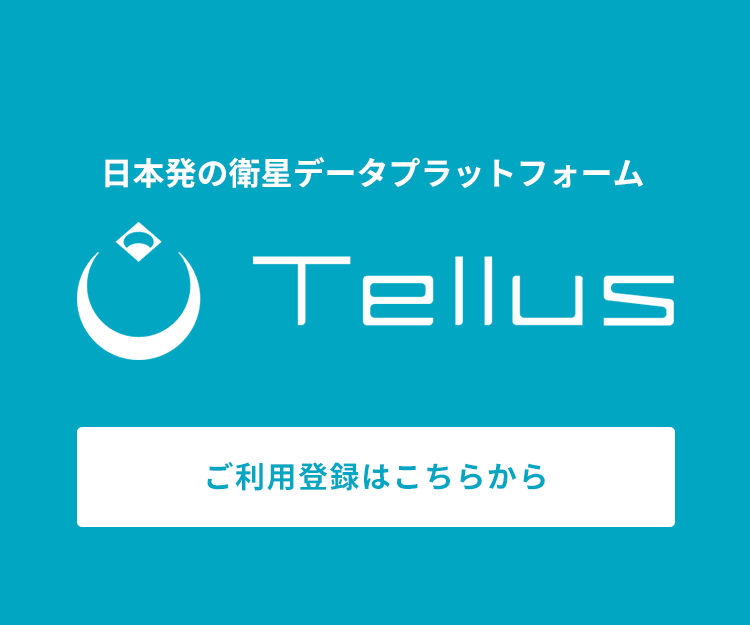Is the Susanoo Shrine built in a location that is resistant to flood damage? We took a look at the enshrined deity and used satellite data to examine the city it is in.
In this article, we will be using the satellite data platform "Tellus" to look into a series of shrines called the Yasaka Shrines, which have both Buddhist and Shinto aspects to them. We will look specifically at their Hikawa sect which enshrines the deity Susanoo. Looking at Shrines From Space! Pretty Cool, Eh?

Shrines are quietly rooted in our lives, with each having a different deity canonized within. The Yasaka shrines, (there are about 40,000 throughout Japan according to the Usajingu Shrine home page), enshrine gods with important duties such as Hachiman, who keeps the country safe, or Ebisu, the god of commerce, who is exalted in Hyogo’s Nishinomiya Shrine.. Each shrine has a different deity, and the power of that deity is what garnishes the faith of the Japanese people.
Allow me to introduce myself. My name is Eri Iguchi, I’m a writer who is a shrine buff and shrine stamp collector who visits over 100 shrines a year (well except for this year because of the COVID-19 pandemic). I’m currently studying Japanese mythology and shrines.
There are hundreds of different kinds of gods in Japan, but Susanoo no Mikoto, the god who protects us from pestilence and disease, is a famous god who appears in many Japanese myths.
A famous story about Susanoo no Mikoto dates as recent as 2011, after the Eastern Japan Earthquake hit. It is said that all shrines dedicated to Susanoo were left undamaged by the tsunami. ★
This was uncovered by professors from the Tokyo Institute of Technology Graduate School in a study they did on Susanoo and damage suffered by these shrines from natural disasters. In their study, they claim that “Susanoo, who is known as the god who prevents disease and water damage, has shrines built in spots that are naturally resistant to flooding and other natural disasters” (from page seven of their thesis).
There are lots of temples dedicated to Susanoo in Tokyo as well. So that begs the question, is there a relationship between spots that see a lot of flooding and the shrines of Susanoo? I’m very curious to find out!
In this article, we will be using the satellite data platform “Tellus” to look at the Yasaka Shrines, which have both Buddhist and Shinto aspects to them. We will look specifically at their Hikawa sect which canonized the deity Susanoo. Looking at Shrines from Space! Looking at Shrines From Space! Pretty Cool, Eh?
What kind of God was Susanoo no Mikoto?

Let’s start with an explanation of who Susanoo no Mikoto was. Susanoo no Mikoto is the younger brother of the Sun Goddess, Amaterasu. Most stories of Susanoo no Mikoto are about how crude of a god he was, with Amaterasu eventually hiding behind a large rock in a cave due to how embarrassing she was of him.
Most of the stories about him are about his over violent and crude nature, but this is all forgiven by him slaying the feared Yamata Orochi. After being expelled from the heavens, he met an old couple in Izumo who were being tormented by an eight headed snake, the Yamata Orochi. He fought and defeated the snake to save a young girl, Kushinada Hime no Mikoto, who he eventually took as his wife. ★ Susanoo defeating the Yamata Orochi was interpreted as a symbol of him protecting Izumo’s Hii river, which is where he made a name for himself as the deity who protects from flooding.
It kind of makes you believe that there may be some spiritual relationship with his shrines being protected from water damage.
The thesis above looks at the Susanoo shrines along Miyagi prefecture’s coast after the tsunami that hit Japan after the Tohoku earthquake.
I looked into it and found that there are 89 Yasaka shrines and 55 Hikawa Shrines, looking only at those which worship Susanoo, in Tokyo (I used this site for my research). That’s a lot of Hikawa Shrines to investigate.
Why are there so many Shrines with the same name throughout Japan?
Before we look at the data, let’s take a moment to think about why there are so many shrines with the same name in the first place?
For example, I found that there were a lot of Hikawa Shrines centered around the Kitasenju part of the Adachi district. If you leave the west exit of JR Kitasenju Station, you’ll find the Senju Hikawa Shrine, the Senju Hon-Hikawa Shrine, the Nakamachi Hikawa Shrine, the Ookawamachi Hikawa Shrine, and the Senju Shrine, which used to be a Hikawa Shrine before it joined an Inari Shrine. Why are there so many shrines with the same name sprawled throughout Japan?
First, we’ll need to go over the Bunrei concept in the religion of Shinto. This is the notion that Japanese gods can divide themselves infinitely, without decreasing their power at all. This ensured such shrines vastly spread out across Japan.

The Head Hikawa Shrine, for example, is the Musashi Ichimiya Hikawa Shrine located in Saitama, and the head Yasaka Shrine is the one found in Kyoto. All of the Hikawa and Yasaka Shrines pray to the same God revered in the head shrine. They do this by praying to the gods who have been divided between all of the different shrines.
In the past, when a certain god gained popularity, their shrines were erected across Japan.
This is why there are so many shrines with the same name throughout Japan.
Taking a look at shrine data in Tohoku
Let’s move on to our investigation. The first place we should look at is the area that got hit hardest by the Tohoku earthquake, Tohoku itself. There are 17 shrines that worship Susanoo picked up in the thesis, which include Yasaka, Yakumo, and Suga shrines. Let’s take a look at data provided by the Geospatial Information Authority of Japan (GSI).
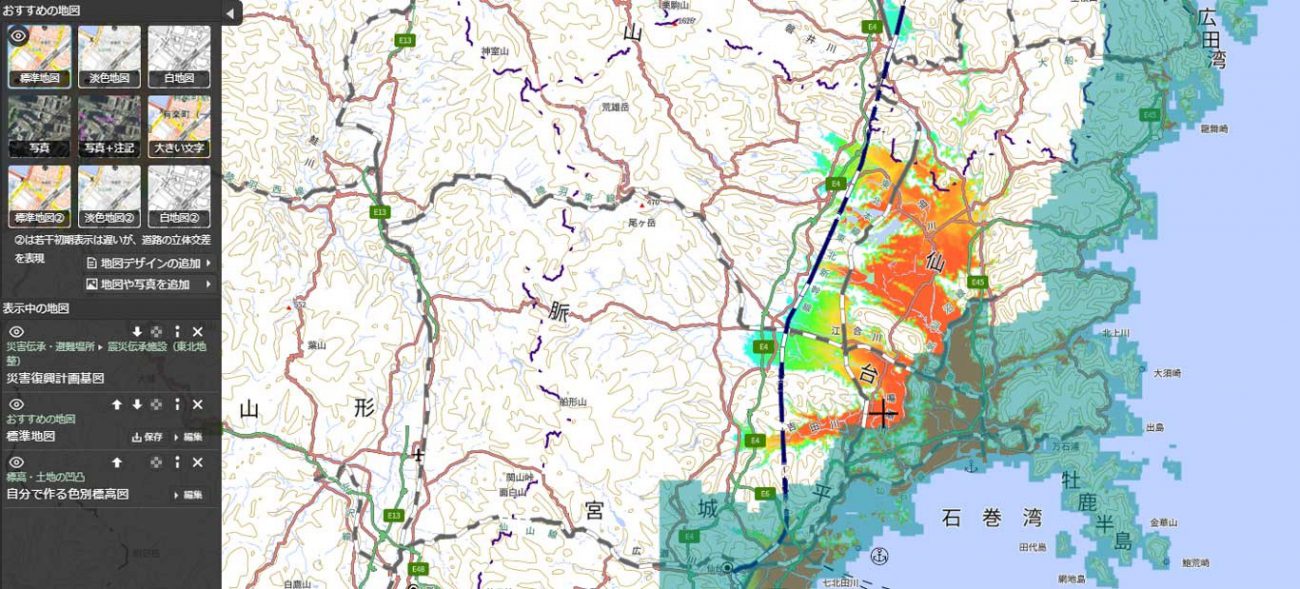
This figure is a map of the GSI that combines elevation data and the disaster recovery plan map. The color of the map indicated an area’s elevation, with red meaning a low altitude, and light blue meaning a higher altitude. Places that show no color indicate an elevation higher than 20 meters.
The blue-green part of the map shows the scope of the”Disaster Recovery Map”. Since the recovery map is meant to be used for planning, it doesn’t necessarily cover all of the areas that were affected by the earthquake.
Press the create button from the top right corner of the GSI map. Then I’ll import a GeoJSON file that I prepared beforehand.
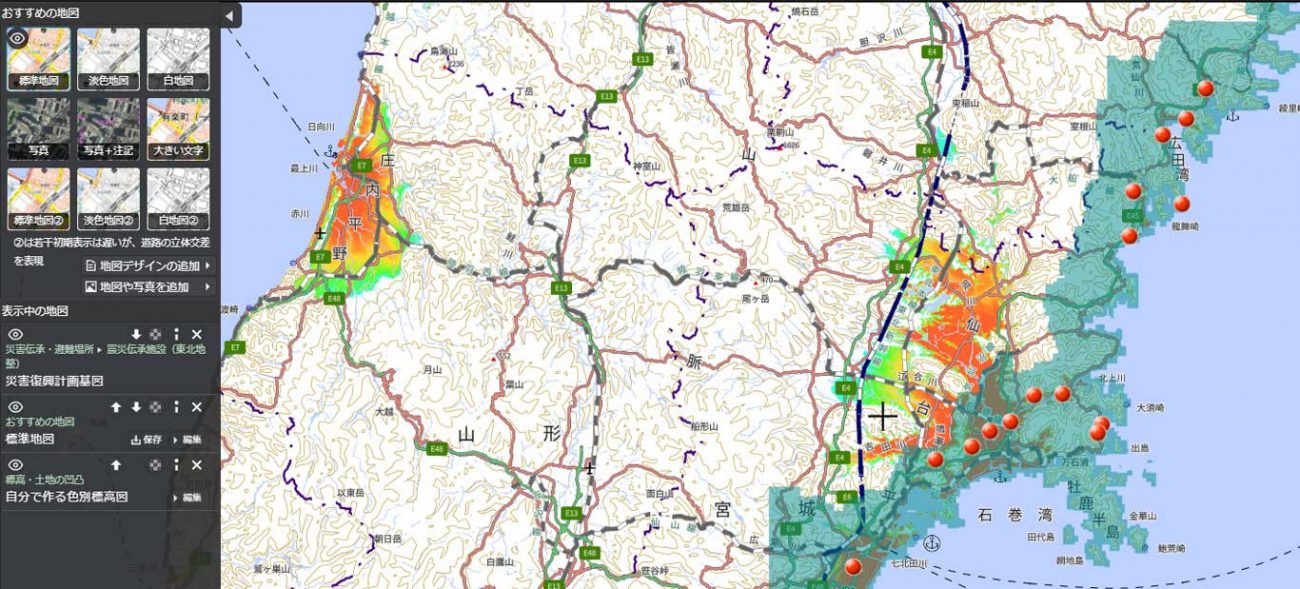
This should map out where all the Susanoo Shrines are on the GSI map.
The shrines seem to be in all of the areas where the tsunami hit, but according to the thesis the only one to receive any real damage in Miyagi was the Yaegaki Shrine in Takasekasano. That is logical as the Yaegaki Shrine is located on a flat patch of land right next to the sea, but that being said, it is at a somewhat higher elevation than the area around it, which you might have guessed from the name Takase (taka meaning high in Japanese). Just looking at this map though, one could conclude that the Susanoo no Mikoto shrines were not likely to be hit by flooding.
When the data showed us
After I looked at Tohoku, I went to Tellus to find Susanoo Shrines in the metropolitan area of Tokyo. This time, I was going to focus on Hikawa and Yasaka Shrines.
I started by inputting a sea level map of the metropolitan area I made beforehand to show areas below 10 meters and above 15 meters which have Kawago and Yasaka Shrines in them via GeoJSON data.
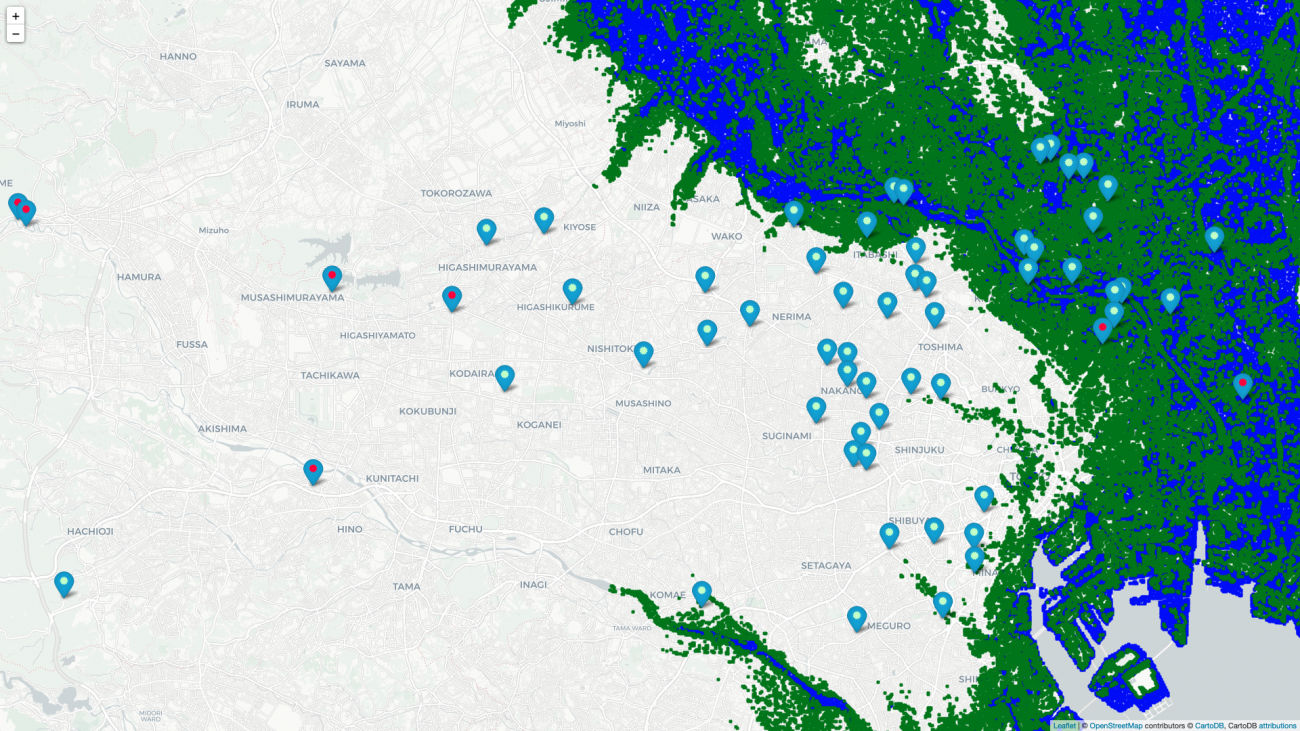
Here is the data I came up with.
The data shows that both Hikawa and Yasaka Shrines exist in spots at low sea levels which are at higher risk of flood damage, which suggests that at least for Tokyo, there isn’t such a good relationship between gods and floods (!)… In fact, the Hikawa Shrine in Senju that we mentioned before can also be seen here on an Adachi Flood Hazard Map. That makes it very hard to say with any confidence at all that a Susanoo Shrine will never have floods.
As the shrines themselves are old, it is pretty common for locations to change throughout history due to floods. People might have brought the deities that protect from flooding to spots that might have experienced flooding in the past. In Meguro, it’s maintained that the Kamimeguro Hikawa Shrine was erected to protect from the disease that was brought to Meguro from frequent flooding.
However, it is likely there were frequent floods of the Arakawa River as well, which was the main water way during the Edo period.
The biggest flood taking place in 1910. This flood set in motion the creation of the Arakawa discharge channel.
In regards to the origin of the shrine, it says on the Senju Hon-Hikawa Shrine Website that,
“In the early Edo period, the Chiba clan used to live here. Using their authority as palace guards (Kobayashi), the owners of the land donated land to create a shrine. In 1910, in order to prevent flooding in Sumidagawa, they erected a discharge channel north of Senju machi, and together with the channel they established a Hikawa Shrine, and the original shrine there was moved to the Sumidagawa River, where it stands today.” (Senju Hon-Hikawa Shrine, on the origins of the shrine.)
This means that the Hikawa Shrine originally located near Arakawa was forced to move due to flooding.
The Tenjin located on the grounds of Nakamachi Hikawa Shrine was also moved in order to avoid flooding in 1787.
This puts an end to our original premise of Susanoo no Mikoto Shrines being less likely to see major flooding.
Comparing the Tohoku map data from the original thesis and the location of the shrines in the metropolitan area shows that there are discrepancies with the locations of each choice of area to build shrines worshipping Susanoo. ★
Maybe we should also take a look at Hikawa Shrines areas, as a lot of them exist in Tokyo but there are none in Tohoku. ★
Why are there So many Hikawa Shrines in the Adachi district?
Let’s take a look at why there are so many Hikawa Shrines in Tokyo. I found there were 15 Hikawa Shrines there alone around the Arakawa area. It looks like Adachi is a Hikawa hot spot.

Evidently, there are approximately 280 Hikawa Shrines located throughout Japan, with most of them in the Tokyo, Saitama, and Kanagawa areas. It’s kind of like finding out one of your favorite chain restaurants is a local brand that doesn’t exist outside your prefecture or state.
According to records of the Musashi Ichimiya Hikawa Shrine, the Head Hikawa Shrine, the first shrine was built in the fifth century BC, under emperor Kosho when it established a link with Izumo Taisha, and eventually began receiving Susanoo’s spirit in the first century. Hikawa Shrine was the one that brought the spirit of Susanoo to Kanto.
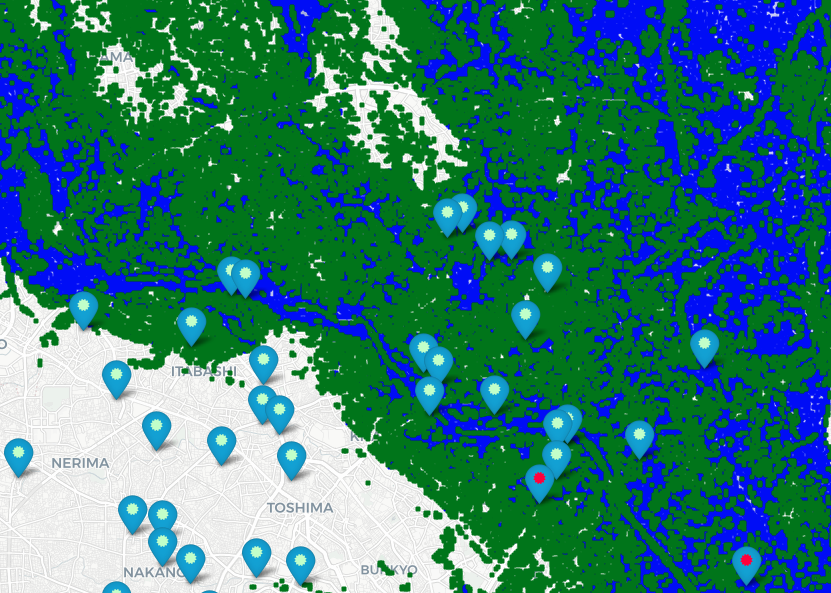
One thing I’d like to point out is that this is an area that was highly susceptible to flooding throughout history. Why is this, though?
As the Ara, which means volatile in Japanese, suggests, the Arakawa river is known to see frequent overflowing. One could assume that since Hikawa enshrines Susanoo, the god known to protect from flooding, that is why there are so many shrines built in his name there, but there is another potential explanation for this. It has to do with the name Hikawa, and the similarities between the Arakawa and Hii River found in Shimane.
Hikawa is literally translated as “ice-cold river”, and can be associated with spring water.
The head shrine is located on the Daimiya plateau which is made up of the Kanto loam layer, known to contain lots of natural spring water. This water was perfect for developing rice fields. The Hikawa Shrines had a relationship with these rice fields and were placed near areas where spring water was found.
I personally believe that shrines were placed near water for this purpose, and those shrines ended up turning into Hikawa shrines.
Let’s look at Yasaka Shrines next. The Head Yasaka Shrine in Kyoto is known for its Gion festival. Yasaka Shrine is also known as an example of a shrine that displays a fusion of Shinto and Buddhism.
There are a few different stories, but it’s said that the sect of Shinto canonized Susanoo’s spirit in a shrine on Ushizuyama mountain in 656. He became the guardian deity of the Gion Shoja Shrine that fused Shinto and Buddhism, and eventually fused together with a Buddhist god that protected his worshippers from disease named Gozu Tenno. This is why Yasaka Shrines are considered a good place to visit for those who wish to fight disease today.
Even for the same god, depending on which head shrine their spirit stems from can change what they protect their worshippers from. If I never looked into it, I may have never learned. Japanese religion sure is interesting!
Final thoughts
I was able to find out a lot of new information by looking at satellite data. When I first heard that Susanoo shrines were less likely to flood, I thought it was a very spiritual notion, but after looking into it, I found that not to be the case. Instead of believing whatever you hear, it might be a better idea to get a hazard map from your local government to find out the best spots to escape flooding.
That being said, there are definitely spots where the Susanoo Shrines managed to miraculously escape major flooding damage. When people in the past decided where they were going to build shrines to worship, they probably thought really hard about where to build them, or maybe they had some kind of godly insight helping them pick the spots.
I visit a lot of shrines, but studying them with this in mind was really informative.
Also looking at a large number of Hikawa Shrines in Kanto, and why many of them are grouped in the Kitasenju area was also interesting. There is a lot of depth to Japanese gods! Some gods can even be worshipped for two different things depending on the sect of Shintoism.
When you visit shrines around Japan, not only do you learn more about that area, but it is also interesting to find out how that shrine ended up there.
However, Kumano Hongu Taisha Shrine, which is the main shrine of Kumano shrines all over Japan, once had an old shrine site in Nakasu called “Oyunohara” at the confluence of Kumano, Otonashi and Iwata Rivers. However, Totsugawa flood damage (aka: Kumano River Flood) that occurred in Meiji 22 year (1889 year) 8 month swallowed the shrine building, and many of the shrine building leaked out. The place where Kumano Hongu Taisha Shrine is located today is the one that moved 4 shrine buildings that escaped the flood damage.
Considering this history, Kumano Shrine, which is said to have 3000 shrines in the country now, it seems unlikely that the shrine foundation was chosen to avoid flooding.
However, this is also something that you will not know until you examine it in detail or visit it in person, and I would like to look forward to when the calm days where you can do fieldwork come.
You can also check the data, and when the Corona disaster calms down, how about actually visiting the shrine? You may be able to discover another aspect of the familiar land from data and history.
[Reference Materials]
– A STUDY ON THE DEITY AND SPATIAL ARRANGEMENT OF SHRINES IN TSUNAMI DISASTER CAUSED BY THE TOHOKU EARTHQUAKE
– Adachi Flood Hazard Map
– Recovery Plan Map (Ministry of Land, Infrastructure, Transport and Tourism, GSI Homepage)
– Waterproofing and disaster information Flood inundation area (Arakawa Downstream River Office page)
– Yao yorozu no kami – Jinja and Jiin Search Site in Japan
– Kumano Hongu Taisha’s old spot “Oyunohara” (Kumano Hongu Tourist Association)
(*The website features information from January 2021)
Shigeki Matsumura’s “The development of Shrines in the Arakawa area in Saitama”
Kamiyu Historical Editor “Learning about Japanese Religion through Gods and Shrines”
Historical People Research ”Everything You Need to Know about Japanese Gods and Shrines, with Pictures!”


